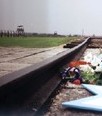Master of Mercy, gather up their souls in the bonds of life. You are their heritage, preserve for us their suffering, and elevate us and all Jews in their merit. May the land not cover up their blood, let there be no place where their cries are not heard...
[Henry Abramson, "Collective Memory and Collective Identity," Carpatho-Rusyn American, XVII, 3, 1994]
Thus begins a Jewish prayer written by survivors of the Holocaust in a genre called Yizker-bukh ("memorial book"). These prayers preserve the memory of Jews who perished in the Nazi concentration and death camps during the Second World War.
While such camps mark the landscape of all of Europe, one alone has come to symbolise all camps combined and the Holocaust in general: Auschwitz.
Surrounded by the legacy
The legacy of the Holocaust surrounds those who live in Central Eastern Europe. For those who grow up in Oświęcim, in the shadow of a death camp, there exists one set of attitudes toward the Holocaust—couched in the framework of day-to-day life; for a generation growing up in North America, physically far removed from the tangible reminders of the Holocaust, there exists another entirely different attitude—rooted in the recognition of death.
Are these visions reconcilable? How does proximity to the site of such a catastrophe affect the way in which we consider the event itself? What is it like to live in Oświęcim today? The question is this: are the cries of those who perished at Auschwitz diminished or increased for a young person living in the Polish town of Oświęcim?
The glorious culture of Europe
Many European cities, once renowned solely for their glorious history and culture, are now irrevocably associated with depravity and death: near Berlin there is Sachsenhausen; beside Munich there is Dachau; and 20 minutes from Prague lies Theresienstadt. But it is Auschwitz that has come to be synonymous with evil and suffering.
Either directly or indirectly, there has recently been a spate of events that have drawn our attention back to Auschwitz. Controversies, crimes and events relating to the Holocaust have overwhelmed the European press, and some of these items have made the news in North America as well.
A disco was opened in August next door to a warehouse where the human remains—specifically, the hair—of the victims of Auschwitz was formerly stored. "Dancing permitted in building where 1000 worked, died," "Dancing over Graves," screamed the headlines around the world.
Dancing on graves?
This disco was built almost concurrently with the reconstruction of the old synagogue in the town. The height of controversy surrounding the discotheque reached its peak as the rebuilt synagogue was ceremoniously opened.
Both are signs of life, albeit of very different kinds of life. The synagogue will attempt to nurture the return of Jewish life in a town where formerly 50 percent of the population was Jewish. The last remaining Jew living in the town died in May of this year.
"The synagogue is beautiful," Magdelena Urban (23), who lives in Oświęcim and works as a guide at the Auschwitz-Birkenau site, told me when I visted the site three days after the synagogue's opening. Other inhabitants were only vaguely aware of its existence. I asked a young mother for directions to the synagogue. As it turned out, we were standing not more than 50 meters from the newly completed structure, but the woman had no idea where it was. She said only that she "thought she had heard of it."
Still another woman, older this time, who declined to give her name, thought it was fine if Auschwitz had a synagogue, but it did not concern her too much. Basically, the synagogue held no personal significance for her. She shrugged and added that she had heard of the Holocaust on television. No, not in the Claude Lanzmann production of Shoah but just "on television."
Western terminology
For many older Poles who lived through the division and occupation of Poland in the Second World War, the "Holocaust" is a term created by television. In Poland, the term does not carry the same emotional significance as in North America. It does not bear the same heavy associations and emotional trauma that it carries in North America; rather it is something created on television for many older Europeans who actually lived through the division and occupation of Poland. The term Holocaust comes from a Greek word meaning "burnt offering." It was only after the Second World War that the word was used to describe the Nazi campaign to exterminate the Jews of Europe.
"But what does 'Holocaust' actually mean," Daniel Puszkiewicz (20) returned my question with another question. The term itself means little to him. He lives in Havířov, Czech Republic, and is a student of political science at the university in Krakow. "I would like to know more," he said, adding that this chapter in history is not taught in enough depth. Indeed, for a university student, his knowledge of this period of history seemed hazy at best. Nevertheless, he demonstrated a keen interest in the subject, and he appreciated the gravity and importance of the Holocaust, even though the word itself carried little concrete significance for him.
Learning history
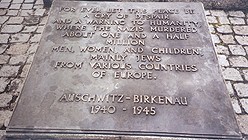 History is taught chronologically in Poland, the Czech Republic and much of Europe. The most recent events are reached last, and if there isn't enough time, well, there isn't enough time. The Holocaust, theoretically (and sometimes in practice) may never be taught, or passed overquickly. This is not the case in North America.
History is taught chronologically in Poland, the Czech Republic and much of Europe. The most recent events are reached last, and if there isn't enough time, well, there isn't enough time. The Holocaust, theoretically (and sometimes in practice) may never be taught, or passed overquickly. This is not the case in North America.
To ask a Pole living in Oświęcim what they know of the Holocaust during the Second World War is to ask the wrong question. It is better to ask what they know of the division of their country, the expulsion of Poles and the forced movement of people. The Holocaust, it seems, does not have anything to do with Poles. The Holocaust is for Jews; while Auschwitz remains deeply embedded in the Polish consciousness—also a place of suffering and evil.
One middle-aged Polish woman made a point of telling me that a second cousin died in Auschwitz, after the war was over. Once again, individual suffering comes first, before the collective suffering of "the other."
Many strange things came to pass in Poland after the war. To tell the story of a Polish family that returned to Oświęcim to live in their home from which they were expelled during the war is not shocking. To learn, however that during the war this house became that of Auschwitz Commandant Rudolf Höss is shocking indeed. Höss lived in this comfortably large house with garden, approximately 100 meters from gas chambers where humans were put to death.
A continent in shambles
To a North American, it may be difficult to conceive of anyone living in the home, because of its proximity to the camp and legacy of its former occupant. A Pole, living in a country in shambles after chaos of unimaginable proportions, could not do otherwise. In a country where even today, the average monthly wage is about USD 350 and real estate is at a premium, one lives in the house that one has.
Is this a disregard for the victims of the Holocaust or rather a return to normalcy, so that life may be once again restored to a town that has survived an immense tragedy?
And what did Magdelena Urban, my tour guide at Birkenau think of the disco?
"They could have found another place for the disco. There are many places where they could have it. Although it [the disco] is not in the old building, they should not have gotten a permit. Now it is too late. The owners have put a lot into making the disco."
Another young Pole living in Český Téšín, a town which lies 50 kilometers from Oświęcim but within the Czech border, asked where, if not there in that warehouse, should the disco then be? He seemed oblivious to the affront the complex represents to many. Outrage has been voiced by survivors and groups such as the Simon Wiesenthal Centre, as well as the North American public at large. Such insensitivity should not be taken to be anti-Semitic but rather as the ignorance it is.
Anti-Semitism
Many in North America would be quick to call such ignorance anti-Semitism. This word is used in North America too loosely. It implies everything from a comment Hillary Clinton made 26 years ago with regards to the Clinton-for-Congress campaign manager, Paul Fray, to the actual murdering of victims in camps. Both of these things, and everything in between, can be called anti-Semitic.
Anti-Semitism is a weighty term, and yet it is used with such startling regularity that we no longer know what it means. There are many things I witnessed while visiting Auschwitz, but especially Birkenau, that were shocking and disrespectful. The disco received worldwide press coverage, but there are attitudes that prevail among visitors to Auschwitz that can be witnessed on a smaller scale, yet on a more regular basis.
What would be more difficult for a survivor returning to Auschwitz-Birkenau? Parents take children when they are still too young to care; adolescents look bored on tours; worst of all, adults laugh and talk between exhibitions and in front of the red brick houses in which prisoners were housed. What kind of conduct shows proper respect? How are we conditioned to respond to tragedy in general? Many of us have been conditioned to expect that citizens of Oświęcim might never laugh or smile, because of their close proximity to Auschwitz.
The forgotten place
The name Auschwitz carries with it a heavy significance for all. The name of Auschwitz II, Birkenau, does not. Birkenau is now a mostly empty expanse although some wooden houses remain. This site does not have the international name of Auschwitz, but it should. While Auschwitz is only six hectares, Birkenau is 175. Visitors can walk a kilometer down the long rail line that ends abruptly after reaching nowhere and see the Monument to Fascism—plaques in at least ten languages commemorating primarily the Jews who died there.
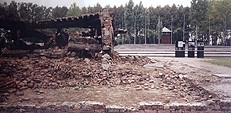 |
| Bombed gas chambers at Birkenau |
A site in transition?
My guide at Auschwitz-Birkenau made it clear that the site at Birkenau will not change in the future. If it is not a site in transition, perhaps it should be. The site is not contained. Locals use it to take short cuts as a quicker way of reaching their homes on the other side.
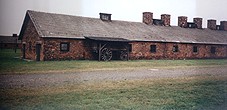 |
| Birkenau |
It is disrespectful. We would not do that, we say. While it certainly is disrespectful, wouldn't we probably do the same thing? For, if fences are not erected, there will be those who will choose the shorter path, cutting through instead of going around.
In North America, the Holocaust—Auschwitz—has been taken up as a symbol. And although at one level understanding of this event eludes human comprehension, North Americans claim to understand, and above all, to remember. Memorials, such as the one in Washington, DC, while important, are imbued with a certain self-righteousness. "Look at how we remember those who were murdered," they seem to loudly proclaim.
We should also remember what happened when Jan Karski, courier of the Polish underground, visited prominent and influential men like Judge Frankfurter in New York and President Roosevelt in the White House, telling at an early date of the "Holocaust" as it was happening. He was sent away with little more than a pat on the back.
In North America, history is studied more thematically rather than chronologically. Less emphasis is placed on dates. But both for students living in Poland and those living in North America today, the topic of the Holocauset remains distant. We expect those who are "living next door" to know more, care more and show more emotion. And many do, but when it is not in the manner to which we are accustomed, or for the victims we expect should be mourned with greater emphasis, we do not accept the emotions of those living in Oświęcim as genuine.
North Americans learn only of the camp at Auschwitz. There would be no reason to focus on learning of the town at Oświęcim otherwise. If North American students learn nothing else from high school history, they remember that Auschwitz is synonymous with death, evil and despair. For those of us who take high school learning any further, from our comfortable position on the western side of the Atlantic, we learn further tales of the death and destruction that took place on a mass scale in Auschwitz.
Berlin is the city of the Friedrich the Great, the flashy 1920s and The Wall. Munich is still known for its art museum, the Hofbräuhaus and Oktoberfest. Weimar is not solely the town of Buchenwald but also that of Goethe and Schiller. Prague does not carry with it much, if any, connection to Theresienstadt. But Oświęcim is Auschwitz and Auschwitz is Oświęcim, in spite of the fact that children must grow up there today. It is their home.
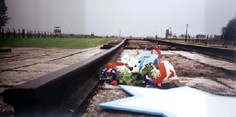 "Let there be no place where their cries are not heard," but let there also be no place where forgiveness cannot prevail for a crime committed in and around Oświęcim; a crime that was no more and no less the responsibility of present-day inhabitants than it is that of neighboring towns, villages and cities of Central Eastern Europe.
"Let there be no place where their cries are not heard," but let there also be no place where forgiveness cannot prevail for a crime committed in and around Oświęcim; a crime that was no more and no less the responsibility of present-day inhabitants than it is that of neighboring towns, villages and cities of Central Eastern Europe.
Andrea Mrozek, 14 October 2000
Moving on:
- Read Andrea Mrozek's reviews of CEE issues in the German press
- Browse through the CER eBookstore for electronic books
- Buy English-language books on Central and Eastern Europe through CER
- Return to CER front page


